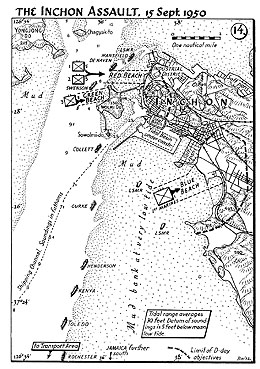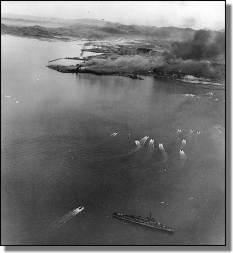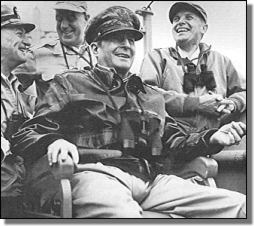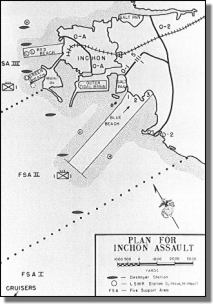|
|
| Plan for the Inchon assault showing the three beaches and the planned positions for gunfire support destroyers and LSMRs. Click on picture for larger view |
From Assault from the Sea by Curtis A. Utz
Just after midnight on D day, 15 September, the Advance Attack Group and the bombardment group formed into an 18-ship column and entered Flying Fish Channel. Two hours later, lookouts in the lead ships noticed a rhythmically flashing light in the darkness ahead of them. The rotating beacon atop the Palmi Do lighthouse guided each ship safely through the narrow passage. Lieutenant Clark, who had activated the light, shivered in his lofty perch not only from the chilly night air but from the thrill of seeing the fleet steaming into Inchon.
At 0508, Mount McKinley dropped anchor in the channel and the gunfire support ships and amphibious vessels moved to their assigned positions. At 0520, Doyle hoisted the traditional signal that had preceded many amphibious assaults in naval history: "Land the landing force."Marines in Horace A. Bass, Diachenho (APD 123) and Wantuck (APD 125) climbed into the LCVPs that would carry them to shore. Fort Marion (LSD 22) prepared to disgorge three utility landing ships carrying tanks and equipment. At 0540, the cruisers and destroyers inaugurated the third day of shelling Wolmi Do and other targets in and around Inchon. Soon after first light, Marine Corsairs launched from Badoeng Strait and Sicily and once again churned up Wolmi Do with bombs, rockets and machine gun fire. Task Force 77 fighters formed combat air patrols to seaward and scoured the roads behind Inchon for enemy reinforcements and supplies.
 |
Click on map for larger view (212k) |
Fifteen minutes before L hour, set for 0630, two of the ungainly LSMRs began an ear-splitting, 2,000-rocket barrage of the reverse slope of Radio Hill on Wolmi Do. Their object was to destroy any remaining mortar positions and prevent reserves from reaching the defenders of the island. Commander Doss's third ship, LSMR 403, moved in front of the LCVPs on their way to the shore and raked Green Beach with rockets and 40mm fire. That done, signalmen on the control vessel lowered flags signaling the assault. The coxswains in the first wave put their controls at full throttle and the landing craft roared across the line of departure.
To cover the final run into the beach, Corsairs from VMF-214 and VMF-323 screamed over the LCVPs and strafed the shoreline. Two destroyers using proximity-fuzed ammunition scoured the forward slope of Observatory Hill and the waterfront with deadly air bursts of shrapnel.
At 0633, G and H Companies of Colonel Taplett's 3rd Battalion, 5th Marines, stormed ashore. When three men stepped off one LCVP, they sank in water well over their heads. Not wanting a repeat of the tragic experience at Tarawa in World War II when many Marines drowned because they had to move long distances through neck-high water, the boat crews moved their vessels closer to the shore. Succeeding waves brought in the rest of Taplett's Marines and ten M-26 Pershing tanks, including one equipped with a flame-thrower and two more with bulldozer blades.
 |
| First and second waves of landing craft move toward Red Beach at Inchon at 0700Z. USS DeHaven DD-727 is in the foreground. Click on picture for larger picture. |
The Marines advanced rapidly across the island. Company H seized and fortified the Wolmi Do end of the causeway to Inchon, while engineers sprinted onto the roadway to lay an antitank minefield. Company G assaulted Radio Hill and by 0655 the stars and stripes flew over that position.
Meanwhile, Taplett landed with his I Company, which moved into areas supposedly secured by the assault units. North Korean troops, hidden in caves on the east side of the island, fired on several I Company squads. When, despite the pleas of a Marine interpreter, the NKPA soldiers refused to surrender, a tankdozer entombed them in their positions.
By 0800, Taplett reported Wolmi Do secured. His leathernecks dug in to fend off any counterattacks and herded the few prisoners of war (POWs) into a dry swimming pool. Some of the NKPA soldiers fought to the last; others, especially local Koreans recently "recruited" by the Communists, readily surrendered. Fanatical enemy troops, however, soon opened up from the nearby islet of Sowolmi Do with light antiaircraft weapons. A reinforced rifle squad and several tanks rapidly moved against them. Supported by Marine Corsairs, the ground force quickly silenced the enemy guns.
 |
| With the first waves safely ashore on Wolmi Do, General MacArthur and several of his key officers share a light moment on the bridge of Mount McKinley AGC-7 |
With the outer harbor secured, at the cost of only 17 wounded, the first phase was now over. General MacArthur asked Doyle to send the following message to Task Force 90: "The Navy and Marines have never shone more brightly than this morning." With a large smile, the old soldier then turned to the Army, Navy and Marine officers gathered on Doyle's flagship and said, "That's it. Let's get a cup of coffee." As he drank his cup of thick Navy java, MacArthur penned a message to General Bradley and the other Joint Chiefs: "First phase landing successful with losses slight. All goes well and on schedule.
